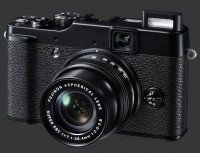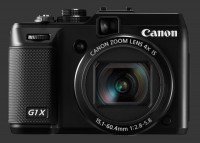Canon Powershot G1 X Review
Canon Powershot G1 X Introduction
The Canon Powershot G1 X is an advanced compact digital camera with a large 1.5" CMOS sensor of 14 megapixels. It is paired with a stabilized 4X wide-angle optical zoom lens, equivalent to 28-112mm in 35mm terms. The G1 X is designed for photographers with dual control-dials, an optical tunnel viewfinder and a hot-shoe for external lighting.
This digital camera has full manual-controls, including manual focus, custom white-balance and choice of metering including spot. It can record full 1080p HD video too. The Canon Powershot G1 X is equipped with a rotating 3" LCD of 920K pixels.
While it resembles previous G-series cameras, the Canon Powershot G1 X is the first to use a large sensor and match its advanced controls with high quality images. They still make a much smaller and more pleasant to use advanced compact with a small sensor and very bright lens in form of the Canon Powershot S100
Canon Powershot S100.
This digital camera review takes a look at the ergonomics, usability, image quality and performance of the Canon Powershot G1 X.
Canon Powershot G1 X Features
Sensor
- 14 Megapixels 1.5" CMOS sensor, 4:3 aspect
- Manually selectable ISO from 100 to 12800
- Auto ISO, 400-1600 limit, 3 rates of change
- Auto or 100% - 400% Dynamic Range
- JPEG, RAW or JPEG+RAW Output
Lens
- 4X Wide-Angle optical zoom
- Optical image stabilization
- 28 - 112mm equivalent focal-length
- F/2.8 - 5.8 Maximum aperture
- F/16 Minimum aperture
- 20cm Minimum focus distance at wide-angle
- 85cm Minimum focus distance at telephoto
- Built-in 3-stop ND filter
Exposure
- PASM Exposure modes
- 1/4000s - 60s Shutter-speed
- 1/4000s @ F/11+ only
- Exposure-Compensation, ±3 EV, 1/3 EV steps
- Flash-Compensation, ±2 EV, 1/3 EV steps
- Manual Flash, 3 levels in Manual mode
- Multi-Segment, Center-Wighed & Spot metering
- Central or AF-point linked Spot metering
- AEB Bracketing, 3 frames, 1/3 - 2 EV steps
- Focus Bracketing, 3 frames, 3 step sizes
- Fixed 1/3 EV exposure steps
Images Parameters
- Automatic, Preset and Custom WB
- WB fine-tuning, 19-steps along 2-axis
- High ISO Noise Reduction, 3 levels
- 10 Built-in Color Modes
- Adjustable Contrast, Sharpness, Saturation, Red, Green, Blue & Skin Tone, 5 steps each
- 16:9, 3:2, 1:1 & 4:5 Cropped aspect-ratios
- Optional Shadow Correction
Focus & Drive
- 1.8 FPS Unlimited JPEG Drive
- 1.1 FPS Unlimited RAW Drive
- Self-Timers: 2s, 10s & 1-10 shots @ 0-30s
- Contrast-Detect autofocus, 2 area sizes
- Autofocus, Macro focus or Manual focus
- Single, Face-Detect or Tracking focus-point
- Single-shot, Continuous and Servo AF
- Optional automatic MF refinement
- Optional MF assist
- Optional AF-Assist lamp
Video
- 1920x1080 @ 24 FPS 16:9 HD Video
- 1280x720 @ 30 FPS 16:9 HD Video
- 640x480 @ 30 FPS 4:3 SD Video
- Quicktime H.264 Codec
- Built-in stereo microphone
- Optional Wind Filter
Viewfinder & Displays
- Rotating 3" LCD, 920K Pixels, 100% coverage
- Optical Tunnel Viewfinder, 85% Coverage
- Digital-Level, Tilt axis only
Body & Construction
- Dual Control-Dials
- Direct Exposure-Compensation dial
- Customizable Shortcut button
- Built-in flash, 7m (W) - 3.1m (T) reach
- Hot-Shoe for external lighting
- Metal tripod mount
- Wired remote terminal
- 1080i HDMI output
- USB 2.0 connectivity
- SDXC memory card slot
- Proprietary Lithium-Ion battery
Canon Powershot G1 X Usability - How easy is it to use?
The Canon Powershot G1 X is a chunky compact camera with a small grip and protruding lens barrel. It is easy to hold, although a deeper grip would be more comfortable. With the right hand on the grip and the left holding the lens, the camera stays very stable. This Canon feels mostly solid and has a substantial weight for its size.

Canon provided with the G1 X with plenty of controls including dual control-dials and a direct EC dial just below the traditional mode-dial. These controls make the Canon G1 X quite efficient to use even though they are not so ergonomic. The rear control-dials spins too easily and is lower on the body than ideal while the EC is just beyond comfortable reach but has strong detents to prevent accidental changes. The front control-dial is well positioned and works perfectly with bare hands though. Still, this is much better than not having those controls.
Given the shape of this camera, the shutter-release is probably in the best position. The power-button behind it is flush enough to avoid turning on the camera inadvertently. To the left are the EC and mode dials on top of each other. The mode-dial has good detents and stays were it is left. Further left is a standard hot-shoe and beyond that is a sliding spring-loaded switch to release the built-in flash.
The rear of this digital camera is very busy. The dominating element is a large 3" LCD with 920K pixels. It is very sharp and has good visibility. The display shows a bright image for framing but previews the exposure when the shutter-release is pressed halfway. This is great and much better than most fixed-lens cameras reviewed here lately.

The LCD is attached to the camera by a rotating hinge with is the only weak part of the G1 X and could break off easily. The hinge is also unfortunately on the side which forces the LCD outwards before being tilted vertically. This makes it more vulnerable and awkward when framing at odd angles. It does allow self-portraits with the camera on a tripod though, something which bottom-hinged LCD cannot do.
Above the LCD is an optical tunnel viewfinder showing part of the lens barrel and a paltry 85% linear coverage, excluding the part of the frame obstructed by the lens. Most Canon G-series have had this problem for a long time. Next to the viewfinder, on the left is the most oddly placed button on the camera, the Shortcut button. This is a programable button which can be set to show options for a number of features. This makes sense for a lot of things but in cases where only two options exist, it should really be a toggle. For example, the ND filter has an Off and On option. The way the shortcut button works, a menu appears with two options and then the user must use the 4-way controller to select one of them. A simple toggle or cycling behavior would be more efficient.
There are direct buttons for selecting the focus-point, locking exposure, changing metering modes, invoking the menu and entering Playback mode. All of these work just as expected. The 4-way controller has each direction assigned to a function: Up is for ISO; Right is for Flash-Mode; Down is for Display mode; and Left is for focus. The most important missing external button is for the self-timer. Really we have no idea who changes Capture display modes more often than the self-timer! During Playback, obviously the display mode is changed more often but in that case, there are plenty of free buttons.
The Function menu is a Canon classic. It invoked using the central button of the 4-way controller. It is different and makes experimenting easy - but may annoy some users - is that this menu does not get dismissed when a shot it taken. Instead, after taking a photo, the menu reappears at the exact position it was before. So, with a simple rotation of the rear control-dial, one can try another setting.

Canon has a remarkable way of keeping their cameras intuitive. For the most part, this carries on with the Powershot G1 X. Most controls behave as expected and there are very few feature interactions, meaning that most settings can be set independently. The two notable exceptions are Manual mode and Dynamic-Range Correction. When the latter is set to 200%, only ISO 200 to 1600 may be used and at 400% the minimum ISO becomes 400. When the former is set, AEB and FC disappear from the Function menu. For flash in manual mode, three power levels can be chosen.
Exposure modes have minor issues. Manual mode can only set Shutter-Speed to 1/2000s at F/5 and below. To go all the way to 1/4000s, the aperture must be stopped down to at least F/11. Aperture and Program modes do not select shutter-speeds below 1s. This is unfortunate for Exposure-Fusion or HDR at night since you have to peform bracketing manually and risk shaking the camera.
Canon Powershot G1 X Performance - How well does it take pictures?
Performance starts with image quality, which is the criteria used as the foundation of our digital camera ratings. Ergonomic issues may get in the way, but in the end, image quality counts the most.
Image Noise & Details
The Canon Powershot G1 X produces superb quality images, the very best from a fixed lens camera and even exceeds top-notch DSLRs. Image noise is extremely low until ISO 800. Above that it starts being just visible and increases slightly at each ISO stop. Output remains perfectly usable until ISO 3200. At ISO 6400, noise eats up fine details and reduces possible print sizes. The maximum ISO of 12800 is noisier and clearly software which still remains usable for small prints and web use. There are 3 levels of noise-reduction available. As usual, the trade noise of softness, so maximum print sizes stay roughly the same.
Color & White Balance
Colors of the G1 X noticeably differ from reality by default. In order to get something better, My Colors must be activated and the Neutral mode selected. This is an improvement but makes images looking dull due to low contrast. For better results, it is preferable to use Custom Color and reduce Saturation, Red and Skin Tones. This removes the excessive red component and pink from skin tones while keeping images with a healthy contrast.
Automatic While-Balance performance is far from perfect. In daylight, there is rarely a problem. It even deals with artificial lighting surprisingly well, leaving a slight yellow or magenta cast depending on the light source. As light levels drop, AWB accuracy goes down as well. The G1 X has a tendency to make things overly blue in low light.

Exposure
This digital camera has an average Evaluative metering system, producing marginally more over-exposure than expected and rarely under-exposure. This produces brighter more print-ready output but clips small and large highlights too often. The exposure-preview shown on the half-press is relatively good though, so its a matter of adjusting the EC dial and starting over. Of course, some moments do not come back, so it is preferable to dial in -1/3 or -2/3 EC in situations where overly bright highlights are present.
It is worth noting that the LCD may clip highlights which are correctly captured and, conversely, the histogram may not show highlights which are clipped. Luckily, Canon shows blinking highlights in the right spots, even if the histogram does not reach the edges.
Auto Focus
Autofocus speed is reasonable for a fixed-lens camera but highly variable. In good light, the G1 X can lock focus in a little less than ½s but it can easily take 1s in typical indoor lighting. At the telephoto end, autofocus takes closer to 1s to lock because the maximum aperture is a dim F/5.8 and lets much less light in for the camera to work with.
Manual Focus is controlled using the rear control-dial. In Manual mode, the Metering button toggles between the metering menu, MF and exposure-parameters. It advanced focus in small discreet steps. Changes in focus are noticeable mostly when MF Assist is enabled which magnifies the center of the frame. An option called called Safety MF lets the camera adjust focus before taking a picture. The Canon Powershot G1 X also has a handy Focus Bracket feature for cases where focus is difficult to confirm.

Speed
The G1 X remains responsive most of the time. Buttons and dials usually get an immediate response but not all actions are quick. In particular, changing exposure modes causes a 1½s before any other action gets acknowledged. The following measurements characterize its performance:
- Power-On: 1½ seconds. Reasonable.
- Power-On to First-Shot: 3 seconds. Slow.
- Autofocus: ¾s on average, often 1s in low-light. Sluggish.
- Shutter-lag: Nearly instant with about 1s blackout. Mostly good.
- Shot-to-shot: 2¼s with or without AF. Slower than average.
- Playback: Under 1s to enter, ¾s to exit. Slower too.
- Power-Off: About 1 second. Good.
- Video: 1s to to start in video mode. 2s from still mode. Slow and slower. Video recording stops in ¼s.
These numbers put the Powershot G1 X on the slow side of digital cameras. With such long shot-to-shot speed and video recording delay, this is clearly not a camera for action. Autofocus is quite manageable in good light but is kind of slow in low light. The video recording delay is half when the camera is ready, underlining the need to have a video mode, rather than simply a video record button.
The Canon G1 X is powered by a proprietary Lithium-Ion battery which provides 250-shots per charge with 50% flash use. This is much lower than average among advanced compact cameras.
Canon Powershot G1 X Conclusion

The Canon Powershot G1 X sports a rather large 1.5" CMOS sensor which gives meaning to the G-series by producing truly high quality images from what is designed to be an advanced photographic tool. Indeed, the G1 X produces superb images with low noise and excellent retention of details. Metering, color and WB are all far from perfect but quite workable.
Where it falters is in terms of speed. The shot-to-shot speed should concern anyone who must follow a moving subject. The same can be said about autofocus in less than ideal conditions. Still, in good light, the Canon G1 X focuses and responds well enough for general use.
The simplicity of the interface and the short-but-versatile optical zoom makes the Canon Powershot G1 X a fun camera to use. Most important controls quickly accessible and - while we noted some imperfections above in this review - better than the majority of digital cameras.
This camera almost has direct competition. The Fujifilm Finepix X100
Fujifilm Finepix X100 has an even larger sensor but no zoom while its sibling, the Fujifilm Finepix X10
Fujifilm Finepix X10, has a considerably smaller one but an awesome mechanical zoom lens. At the same price many photographers will consider an SLD, thinking about the flexibility of having interchangeable lenses. However, the all-in-one aspect of the G1 X will be even more attractive to those looking for image quality without hassles. For the same market it matters that the G1 X has an optical zoom rather than a prime lens.
 |
Please Support Neocamera
All information on Neocamera is provided free of charge yet running this website is a huge endeavor. Purchases made via affiliate links found throughout the site help keep it running and up-to-date. There is no additional cost to you, so please consider buying via these links to our affilates:
If you found any information on this site valuable and did not purchase via our affiliate links, please considering donating via PayPal:
Any amount will be greatly appreaciated. Thank you for your support!
Canon G1 X Highlights

Sensor-Size: 19 x 14mm

Actual size when viewed at 100 DPI
| 14 Megapixels Fixed Lens | ISO 100-12800 |
| 4X Wide Optical Zoom | Shutter 1/4000-60s |
| Built-in Stabilization | Full manual controls, including Manual Focus |
| 1.9 FPS Drive, 6 Images | Custom white-balance with 2 axis fine-tuning |
| 1920x1080 @ 24 FPS Video Recording | Spot-Metering |
| 3" LCD 920K Pixels | Hot-Shoe |
| Lithium-Ion Battery | |
| Secure Digital Extended Capacity |
Updates
2024.11.18

Best 2024 Photography Gifts for Every Budget
Great gifts for photographers and photo enthusiasts selected for every budget among the best products of 2024.
2024.08.07

Eye Protection Tips for Professional Photographers
The four main considerations for professional photographers regarding eyewear.
2024.07.14

Fujifilm X100VI Review
Flagship fixed-lens compact digital camera with a 40 MP sensor and Image-Stabilization, a first for the series. Retro design featuring dual control-dials, plus direct ISO, Shutter-Speed and EC dials. Its hybrid viewfinder can switch between EVF and OVF mode.
2024.05.09

Fujifilm GFX100 II Review
Flagship 102 Megapixels Medium-Format Mirrorless Digital Camera with 8-Stop 5-Axis IBIS, 8 FPS Drive, 8K Video and 400 MP Super-Resolution capture in a weatherproof and freezeproof body with dual control-dials and dual memory-card slots.
2024.04.03

Fujifilm X-T5 Review
Newest Fujifilm flagship boasting a 40 MP APS-C sensor, 5-axis IBIS with 7-stop efficiency, 15 FPS continuous drive, 6.2K Video capture, dual control-dials and dual SDXC UHS-II slots in a sturdy weatherproof and freezeproof body.
2023.11.20

Best Digital Cameras of 2023
Find out which are the Best Digital Cameras of 2023. All the new Mirrorless Digital Cameras from entry-level to high-end professional.
2023.07.10

Fujifilm X-H2 Review
40 Megapixels APS-C Hybrid Mirrorless Digital Camera with 7-stop IBIS. Fastest shutter ever and 8K video capture. Large builtin EVF with 0.8X magnification and 5.8 MP, plus an Eye-Start Sensor. Packed with features and large number of controls in a weatherproof and freezeproof body.
2023.05.07

Sony FE 20-70mm F/4G Review
Review of the unique Sony FE 20-70mm F/4G lens. The optical zoom of this lens spans ultra-wide-angle and medium focal-length coverage, making it one of the most versatile Full-Frame lenses on the market.
2023.01.15

Huion Inspiroy Dial 2 Review
Review of the Huion Inspiroy Dial 2 tablet, a medium sized drawing surface with dual dials and customizable buttons. Connects via USB-C or Bluetooth 5.0 with Windows, Linux and Android support.
2022.12.08

How to Pack for a Photo Trip
Find out how to pack for a travel photography trip, carry your gear safely while meeting airline regulations.
2022.11.13

Best Digital Cameras of 2022
The best digital cameras of 2022. A short list of the most outstanding models in their respective categories. Choose one for yourself or as a gift.
2022.09.21

Pentax DA* 60-250mm F/4 SDM Review
Review of the Pentax DA* 60-250mm F/4 SDM, the constant-aperture telephoto zoom with the highest zoom-ratio on the market.













